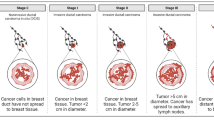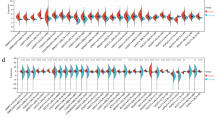Abstract
Purpose
To associate the global gene expression of B7/CD28 family transcripts with pathologic features of colon cancer, we determined the B7/CD28 family transcripts in peripheral blood mononuclear cells (PBMCs) from normal subjects and patients with adenomatous polyps and colon cancer, and correlated the results with pathologic features of colon cancer.
Methods
PBMCs from age-matched normal subjects and patients with adenomatous polyps and colon cancer were analyzed for peripheral blood transcripts (PBTs) of B7/CD28 family using real-time PCR. Differences in expression levels of B7/CD28 PBTs across all cancer stages and between colon cancer patients with or without microscopic lymphovascular invasion (LVI) were analyzed.
Results
The results showed a significant upregulation of PBTs of co-inhibitory molecules such as B7-H3 and PD-1 and a significant PBT downregulation of co-stimulatory molecules including CD28 and ICOS in colon cancer patients. Furthermore, the increase of B7-H3 PBT was strongly associated with tumor invasion (P = 0.025) and advanced TNM stages (P = 0.019), whereas the decline of co-stimulatory ligand B7-H2 PBT was related to regional lymph node metastasis (P = 0.028) and aggressive tumor invasion (P = 0.031). In addition, the ratios of PBT expression of CD28 family to B7 family such as CTLA-4 to B7-H2 and PD-1 to B7-H2 were significantly higher in colon cancer patients with microscopic LVI than in those without LVI (P = 0.001 and P = 0.016, respectively).
Conclusions
Our results suggest that B7/CD28 family PBTs may serve as valuable markers reflecting the pathological features of colon cancer.


Similar content being viewed by others
References
Barber DL, Wherry EJ, Masopust D, Zhu B, Allison JP, Sharpe AH et al (2006) Restoring function in exhausted CD8 T cells during chronic viral infection. Nature 439:682–687
Boorjian SA, Sheinin Y, Crispen PL, Farmer SA, Lohse CM, Kuntz SM et al (2008) T cell coregulatory molecule expression in urothelial cell carcinoma: clinicopathologic correlations and association with survival. Clin Cancer Res 14:4800–4808
Choi IH, Zhu G, Sica GL, Strome SE, Cheville JC, Lau JS et al (2003) Genomic organization and expression analysis of B7-H4, an immune inhibitory molecule of the B7 family. J Immunol 171:4650–4654
Crispen PL, Sheinin Y, Roth TJ, Lohse CM, Kuntz SM, Frigola X et al (2008) Tumor cell and tumor vasculature expression of B7-H3 predict survival in clear cell renal cell carcinoma. Clin Cancer Res 14:5150–5157
Curiel TJ, Wei S, Dong H, Alvarez X, Cheng P, Mottram P et al (2003) Blockade of B7-H1 improves myeloid dendritic cell-mediated antitumor immunity. Nat Med 9:562–567
Dong H, Strome SE, Salomao DR, Tamura H, Hirano F, Flies DB et al (2002) Tumor-associated B7-H1 promotes T cell apoptosis: a potential mechanism of immune evasion. Nat Med 8:793–800
Greenwald RJ, Freeman GJ, Sharpe AH (2005) The B7 family revisited. Annu Rev Immunol 23:515–548
Hirano F, Kaneko K, Tamura H, Dong H, Wang S, Ichikawa M et al (2005) Blockade of B7-H1 and PD-1 by monoclonal antibodies potentiates cancer therapeutic immunity. Cancer Res 65:1089–1096
Jeong HY, Lee YJ, Seo SK, Lee SW, Park SJ, Lee JN, Choi I et al (2008) Blocking of monocyte-associated B7-H1 (CD274) enhances HCV-specific T cell immunity in chronic hepatitis C infection. J Leukoc Biol 83:755–764
Konishi J, Yamazaki K, Azuma M, Kinoshita I, Dosaka-Akita H, Nishimura M (2004) B7-H1 expression on non-small cell lung cancer cells and its relationship with tumor-infiltrating lymphocytes and their PD-1 expression. Clin Cancer Res 10:5094–5100
Kryczek I, Zou L, Rodriguez P, Zhu G, Wei S, Mottram P et al (2006) B7-H4 expression identifies a novel suppressive macrophage population in human ovarian carcinoma. J Exp Med 203:871–881
Loos M, Giese NA, Kleeff J, Giese T, Gaida MM, Bergmann F et al (2008) Clinical significance and regulation of the costimulatory molecule B7-H1 in pancreatic cancer. Cancer Lett 268:98–109
Ohigashi Y, Sho M, Yamada Y, Tsurui Y, Hamada K, Ikeda N et al (2005) Clinical significance of programmed death-1 ligand-1 and programmed death-1 ligand-2 expression in human esophageal cancer. Clin Cancer Res 11:2947–2953
Prasad DV, Nguyen T, Li Z, Yang Y, Duong J, Wang Y et al (2004) Murine B7-H3 is a negative regulator of T cells. J Immunol 173:2500–2506
Roth TJ, Sheinin Y, Lohse CM, Kuntz SM, Frigola X, Inman BA et al (2007) B7-H3 ligand expression by prostate cancer: a novel marker of prognosis and potential target for therapy. Cancer Res 67:7893–7900
Simon I, Katsaros D, Rigault de la Longrais I, Massobrio M, Scorilas A, Kim NW et al (2007) B7-H4 is over-expressed in early-stage ovarian cancer and is independent of CA125 expression. Gynecol Oncol 106:334–341
Thompson RH, Kuntz SM, Leibovich BC, Dong H, Lohse CM, Webster WS et al (2006) Tumor B7-H1 is associated with poor prognosis in renal cell carcinoma patients with long-term follow-up. Cancer Res 66:3381–3385
Wang L, Fraser CC, Kikly K, Wells AD, Han R, Coyle AJ et al (2005) B7-H3 promotes acute and chronic allograft rejection. Eur J Immunol 35:428–438
Wu CP, Jiang JT, Tan M, Zhu YB, Ji M, Xu KF et al (2006) Relationship between co-stimulatory molecule B7-H3 expression and gastric carcinoma histology and prognosis. World J Gastroenterol 12:457–459
Yao S, Chen L (2006) Reviving exhausted T lymphocytes during chronic virus infection by B7-H1 blockade. Trends Mol Med 12:244–246
Zang X, Thompson RH, Al-Ahmadie HA, Serio AM, Reuter VE, Eastham JA et al (2007) B7-H3 and B7x are highly expressed in human prostate cancer and associated with disease spread and poor outcome. Proc Natl Acad Sci USA 104:19458–19463
Acknowledgments
This work was supported by the Korea Science and Engineering Foundation (KOSEF) grant funded by the Korea government (MOST) (No. R13-2007-023-00000-0) (I.Choi).
Conflict of interest statement
None.
Author information
Authors and Affiliations
Corresponding author
Additional information
H. Lee and J. H. Kim have contributed equally.
Electronic supplementary material
Below is the link to the electronic supplementary material.
Rights and permissions
About this article
Cite this article
Lee, H., Kim, J.H., Yang, S.Y. et al. Peripheral blood gene expression of B7 and CD28 family members associated with tumor progression and microscopic lymphovascular invasion in colon cancer patients. J Cancer Res Clin Oncol 136, 1445–1452 (2010). https://doi.org/10.1007/s00432-010-0800-4
Received:
Accepted:
Published:
Issue Date:
DOI: https://doi.org/10.1007/s00432-010-0800-4




